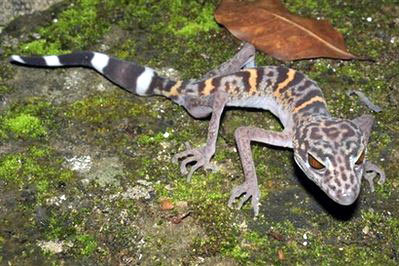Discovered 163 new species in the Mekong region
After a period of synthesis, a working environmental research group for the International Nature Fund (WWF) has just announced 163 new species discovered last year in the Mekong region.
WWF said that in 2008 scientists discovered 100 species of plants, 28 species of fish, 18 species of reptiles, 14 species of amphibians, two mammals and one bird in this area.
Among these, there are frogs with fangs (Limnonectes megastomias) specialized in eating birds and insects (living in northeastern Thailand); Cat Ba gecko species (Goniurosaurus catbaensis) has brown eyes - big orange like cat eyes, on the body there are leopard-like spots (living on Cat Ba island in Northern Vietnam); a serpent snake-like snake in Vietnam .

Cat Ba leopard - a new species discovered in Vietnam
(Photo: AP)
WWF researchers also warn of the effects of climate change, including a sudden increase in droughts and floods, threatening the habitat of these new species. Besides the " traditional " threats such as poaching, polluting and destroying the living environment.
" Some species are able to adapt to climate change, but many species do not and can become extinct in large scale, " said Stuart Chapman, WWF's Greater Mekong Program Manager.
In 2009, the team first discovered the nest of nocturnal white-eared heron in Vietnam; the bald-headed bird singing in Laos ( Bulbul Pycnonotus ); the pipe-nosed bat ( Murina harpioloides ) that lives in southeastern Vietnam and the Nonggang pitcher bird prefers to fly in tropical forests with many cracks of limestone, sloping ground and underground streams on the Vietnamese border - Central
The research team also announced that 3 areas of Mi LangBiang ( Crocias langbianis ) are endangered that can live in Vietnam. This bird has dark gray and brown fur, white fur under the belly.
WWF is planning to publish an annual publication listing newly discovered species in the Mekong, which has called for increased efforts to ensure new species are discovered by preserving large forests and The natural river system that they need to survive.
- Find more than 1,000 new species in the Mekong Subregion
- 139 new species were discovered in the Mekong region
- Mekong subregion: the most important biological region on the planet
- Discovering many new species in Vietnam
- Ecological crisis threatens the Mekong sub-region
- More new species discovered in the lower Mekong
- Discovered 3 new animals in Vietnam
- Discovered a dragon-like lizard
- Protection of mangrove ecosystem in Mekong Delta
- The dam will make the Mekong catfish extinct
- Many new species were found in the Mekong and Papua New Guinea rivers
- Mekong sub-region focuses on green growth
 Animal 'suffering' after hibernation
Animal 'suffering' after hibernation Why do goats climb well?
Why do goats climb well? Scientists were surprised to see chimpanzees eating turtles
Scientists were surprised to see chimpanzees eating turtles Giant catfish died deadly due to drought in Thailand
Giant catfish died deadly due to drought in Thailand